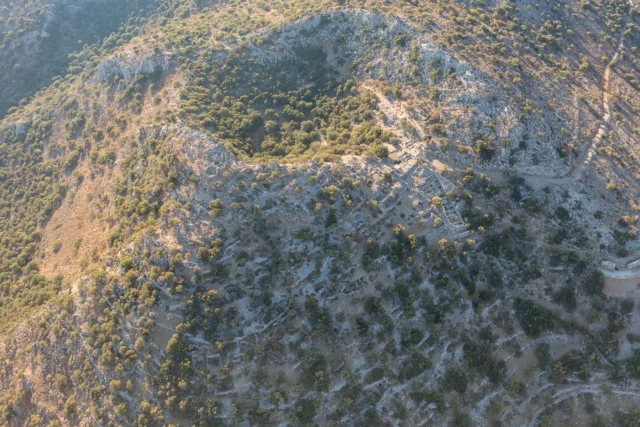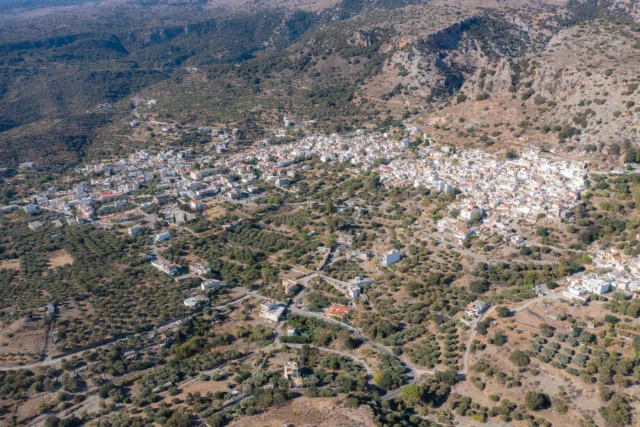Olous or Olus (Ancient Greek: Ὄλους, or Ὄλουλις) was a harbor city of ancient Crete. Today, the majority of the ruins are submerged and lie off the coast of the present-day town of Elounda, Crete, Greece. According to the Stadiasmus Maris Magni, it had a harbor and was located 260 stadia (approximately 41 to 50 km) from Chersonasus and 15 stadia (approximately 2.4 km) from Camara. The site of Chersonasus is now occupied by the modern village of Chersonisos, which is about 25 km east of Heraklion. Camara was a small town near Olous, possibly located at the site of modern Kamara, a small village near Elounda.
History
Olous is believed to have been one of the original one hundred cities that formed Crete. The city was inhabited from the Early Minoan period throughout the Classical and Hellenistic periods until its submergence sometime in the early centuries AD. Although it had a small territory, its strategic position in the main gulf of Eastern Crete, the Mirabello, gave it significant importance. It had one of the best natural harbors on the island.
Minoan Period
A Minoan cemetery was excavated in 1937 at Elounda near the modern town of Agios Nikolaos. The mixed nature of the sarcophagi and burial gifts suggested the cemetery was in use from the Late Minoan IIIA1 to IIIB periods (c. 1400-1240 BC). The presence of cremations in pithoi at the periphery of the cemetery is significant. These constitute the earliest group of cremations in Crete and may be associated with the Mycenaeans who reached Crete and introduced this new funerary custom.
Classical and Hellenistic Periods
Olous had an advantageous strategic position within the maritime networks in both the Aegean and the broader Eastern Mediterranean during the Classical and Hellenistic periods. The city was located on the main maritime trade route that linked the Eastern and Western Mediterranean. Its small territory was protected by a series of forts, including one on Mount Oxa, which was situated on the southern border of the city.
After continuing boundary disputes with the hillfort of Lato, the citizens of Olous eventually entered into a treaty with those of Lato. There was a temple to Britomartis in the city. A wooden statue of the goddess was erected by Daedalus. Her effigy is represented on the coins of Olous. The Ptolemaic naval fleet commander Callicrates was honored by the citizens of Olous and received honorary citizenship.
Like Itanos, a coastal city situated at the extreme northeastern tip of Crete, Olous had a connection with Ptolemaic Egypt. Along with the bay of Suda in western Crete, Olous is one of the best natural anchorages in Crete. A bronze weight of the 2nd century BC [Rhodian-type] is attributed to the Cretan city of Olous.
It has been demonstrated that the coastal cities of Crete were, surprisingly, unfortified. However, a submerged wall recently discovered at Olous may be a Hellenistic fortification, prompting a reassessment of this important harbor city.
Archaeological Investigation
Archaeologists have discovered ancient texts within the ruins linking the town with the ancient cities of Knossos and the island of Rhodes. The only visible remnants of the city are some wall bases. A significant part of the city now lies underwater.
Underwater geophysical prospection has been conducted at ancient Olous using electrical resistivity tomography and magnetic gradiometry to reconstruct the built environment that now lies on the sea bottom. The results of the investigation were promising. Both magnetic and electrical resistivity tomography revealed interesting archaeological features and provided useful information on the ancient city. The methods were successfully applied in the shallow marine environment for mapping submerged archaeological remains.
The 3D inverted dynamic electrical resistivity tomography lines showed promising results. The horizontal depth slices managed to pinpoint the lateral and vertical continuation of a possible fortress wall. The slices show a much longer and wider wall than what was originally believed. The existence of two further buried targets in the respective depth slices could indicate anthropogenic structures since there is no evidence to support the geological origin of these anomalies.
The magnetic map in both bays revealed variations of the magnetic gradient. The geometry and their orientation aligned with visible structures on the sea bottom enhance the possibility that these features represent archaeological structural elements.
Concerning the static electrical resistivity tomography results, many interconnected linear resistive targets were revealed. These targets are highly probable to form some sort of buried underwater structure, such as a public building or walls. Some of the targets could be verified in situ and identified by archaeological inspection though diving.
Site: Key Points
- Construction Period: Early Minoan – Hellenistic Period
- Location: Elounda, Crete, Greece
- Dimensions: Small territory
- Historical Significance: Strategically important harbor city
- Current Status: Partially submerged, with visible wall bases
References
Apostolakou, V., and Zografaki, V. 2009. New inscribed stones in Olous. In Martinez Fernandez, A., editor. Estudios de Epigrafia Griega. Canary Islands, Spain: University of La Laguna.
Ashton, R. H. J. 1987. Rhodian-Type Silver Coinages from Crete. Schweizer Münzblätter 146.
Cantillena, R., and Carbone, F., editors. 2020. Monetary and Social Aspects of Hellenistic Crete. Athens, Greece: Scuola Archeologica Italiana di Atene.
Delanaye, L., and Doyen, C., editors. 2022. Pondera Antiqua et Mediaevalia II. Louvain-la-Neuve, Belgium: Presses universitaires de Louvain.
Oikonomou, D., Plageras, A., Papadopoulos, N., Symirdanis, K., Cantoro, G., Argyriou, A., Manataki, M., and Polykretis, C. 2023. Underwater geophysical prospection in ancient Olous, Crete. In Proceedings of the 15th International Conference on Archaeological Prospection.
Papadakis, N. P. 1988. Κρητική Εστία 1.
Stefanakis, M. I., and Stefanaki, V. Ε. 2006. Ρόδος και Κρήτη: Νομισματικές συναλλαγές, επιρροές και αντιδράσεις στις αρχές του 2ου αι. In Το Νόμισμα στα Δωδεκάνησα και τη Μικρασιατική τους Περαία. Athens, Greece.
Stambolidis, N. C., editor. 2001. Cremations of the Bronze Age and Early Iron Age. Athens, Greece.
Stefanaki, V. E., and Kroll, J. H. 2022. Rhodian Bronze and Lead Weights (including one attributed to Olous, a Cretan city under Rhodian domination). In Delanaye, L., and Doyen, C., editors. 2022. Pondera Antiqua et Mediaevalia II. Louvain-la-Neuve, Belgium: Presses universitaires de Louvain.























There are no comments yet.